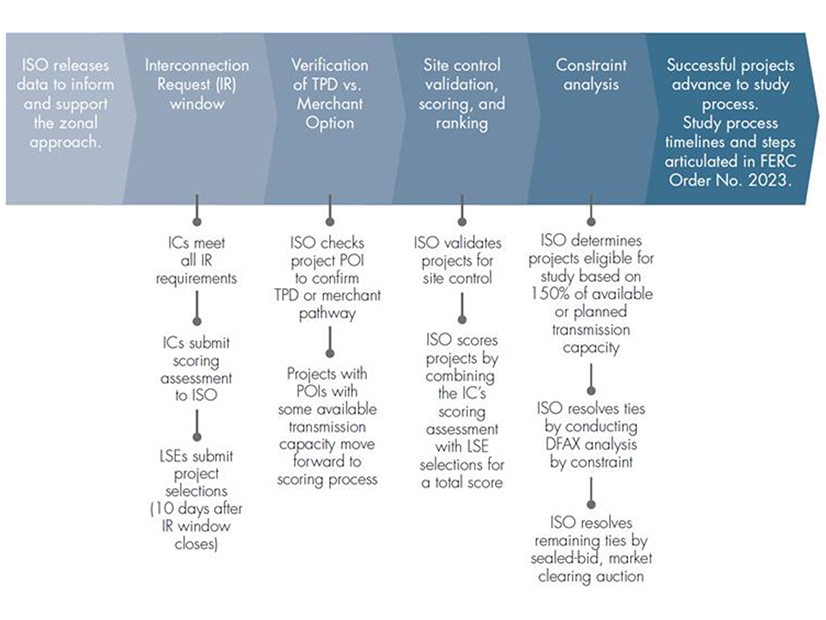
Stakeholders still are seeking clarity on details in CAISO’s plan to streamline its interconnection process after the ISO released its final proposal to address the issue after 10 intensive months.
“I know it’s been a long haul and has felt a little bit like an endurance sport for a little while, and we’re not done,” Danielle Mills, CAISO principal of infrastructure policy development, said during an Interconnection Process Enhancements working group meeting April 4. “But we’re getting to a point where we’re ready to propose this set of reforms as the final proposal.”
The 2023 Interconnection Process Enhancements final proposal is designed to deal with the “unprecedented volume” of interconnection requests the ISO received last year by reducing the number it will have to study. It will complement — but not replace — the ISO’s compliance filing for FERC Order 2023, which requires transmission providers to revise their interconnection rules.
CAISO released the plan March 28, one day before it received FERC approval to close this year’s interconnection request window to allow it more time to study Cluster 15 applications. (See CAISO Can Close 2024 Interconnection Window, FERC Rules.)
But stakeholders participating in the April 4 meeting sought clarity over a few key aspects of the proposal before it goes to a vote by the ISO’s Board of Governors, particularly around the plan’s “zonal approach” and the scoring criteria used to rank interconnection requests.
Zonal Approach
A key feature of the CAISO proposal is its zonal approach, which prioritizes the interconnection of resources seeking to use available transmission capacity in areas where planned capacity additions were approved in the ISO’s 2022/23 transmission plan as determined by state and local regulatory authority resource planning portfolios.
Zones are defined by available capacity based on constraints and the California Public Utilities Commission’s resource planning portfolio. A zone with at least 50 MW of available transmission capacity is identified as a Transmission Plan Deliverability (TPD) zone, while a zone with zero available capacity is called a “Merchant option” zone, indicating it could be available for interconnection by merchant projects.
CAISO is defining zones based on available and planned capacity from the previous year’s transmission plan base portfolio, using the portfolio to calculate overall systemwide capacity. But some stakeholders have struggled to understand how the ISO determines available capacity and evaluates projects in each zone.
Sushant Barave of Clearway Energy Group questioned how projects would be evaluated if an applicant is in a TPD zone but with a point of interconnection (POI) with no available capacity.
“If a project is seeking to be studied in a zone that has available capacity, one of the tests we’re going to do is check the POI of the project to determine if it has available capacity or not,” said Bob Emmert, senior manager of interconnection resources at CAISO. “And if the answer is you’re in a TPD option zone but your POI is actually behind constraints that have no capacity to make your project deliverable, then your project will not be studied.”
Mills emphasized that the amount of capacity identified for each zone doesn’t need to be exact.
“This is really just a way of gauging relative LSE interest to align with their portfolios,” she said.
Scoring Criteria
The ISO also is working on implementing scoring criteria to rank projects based on factors including project readiness, LSE interest and non-LSE — or commercial — interest.
Stakeholders are concerned the scoring system gives an unfair advantage to projects backed by LSEs.
Under the system, LSEs can award projects points based on a 1-to-100 scale, with the points representing the percentage of capacity the LSEs would assign to the projects, but non-LSEs can award only a maximum of 25 points. The primary reason for the difference, the ISO said, is that LSEs must meet specific resource adequacy and procurement requirements while non-LSEs have no such obligations, although they might be serving a commercial interest.
“We’ve had a lot of stakeholder comments about different weighting factors that we should apply to the scores and how much influence the LSE or commercial interest should have on the scoring process as a whole,” Mills said. “The scoring process, and particularly the commercial interest process, is really intended to be a way of getting a ranking of projects that can processed.”
In an interview with RTO Insider, Chris Devon, director of energy market policy at Terra-Gen, questioned if the scoring process was open and transparent given LSE influence. In particular, he highlighted that CAISO’s proposal calls for FERC-jurisdictional LSEs to outline how they would award points in their tariff.
“I believe that it would be more appropriate to see the CAISO outline some guidelines and requirements within their tariff. But the final proposal lacks any detail on how those LSEs would need to administer those processes to award the points, other than just kind of indicating the time frame,” Devon said. “We would like to see that be more clearly defined to ensure that there is no negative impact to competition and open access.”
Additionally, if projects aren’t local or long-lead time, such as offshore wind or geothermal energy, they will have to compete for megawatt allocation with LSEs, which are given priority, Devon said, potentially reducing competition.
“We have seen the benefits of competition in California, where there’s a robust number of independent developers that have been able to develop projects cost-effectively in a manner that keeps cost borne by ratepayers down and kind of shares in the benefit of diversity of supply,” he said.
Margaret Miller, director of government and regulatory affairs at ENGIE North America, also expressed concern LSEs were given too much influence.
“I know there are a lot of competing interests in this category, and I appreciate what the ISO has done to try and balance the concerns here on the scoring criteria,” Miller said during the April 4 meeting. “But when I look at the scoring criteria, for project viability as a developer, I just don’t see a lot of actionable steps we can take to show our project is viable outside of LSE interest, which leads me to believe if we don’t get LSE interest we’re not going to be studied. We’re really struggling with this because I think there’s some commercially viable, good projects that just won’t get into the queue at all.”
Emmert responded, emphasizing the role of LSE interest in ranking projects.
“If we didn’t have a scoring mechanism, and if we got rid of this and what’s left of the scoring mechanism without a load-serving entity component, we think we’d have so many [scoring] ties that we’d have basically a process for auctions,” Emmert responded, noting that the proposed rules call for the ISO to conduct a market-clearing, sealed-bid auction for the right to be studied in a specific zone in the case of a tie in scoring points.
“If we don’t have scoring, well, then we go to auction, and we heard pretty darn clearly that nobody wants an auction, not even the load-serving entities.”
Stakeholders also expressed concern LSEs can pursue multiple projects, while non-LSE off-takers can submit only letters of interest for one.
“LSEs can allocate their points to any number of projects and in fact, multiple smaller projects, as long as they don’t exceed their points … but here, you’re imposing a limitation on non-LSEs,” said Susan Schneider of Phoenix Consulting. “There isn’t any apparent reason why they shouldn’t be allowed also to sponsor several smaller projects.”
Mills said non-LSEs aren’t given priority because they fall outside the CPUC portfolio.
“These non-LSE off-takers are not incorporated into the portfolios that we’re talking about here. We’re talking about basing a lot of this on available capacity and portfolios and where there is available transmission. The non-LSE off-takers are sort of outside that process,” Mills said. “This is an opportunity for them to participate and express any interest in going beyond those procurement needs, but it’s also not as central to the need for us to bring on resources to meet reliability needs.”
The ISO expects to submit its Order 2023 filing in late April or early May. Starting January 2025, the ISO will begin evaluating interconnection requests based on proposed criteria.

